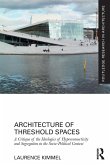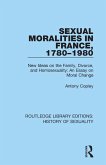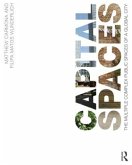Social Practices and City Spaces
Towards a Cooperative and Inclusive Inhabited Space
Herausgeber: Tsoukala, Kyriaki
Social Practices and City Spaces
Towards a Cooperative and Inclusive Inhabited Space
Herausgeber: Tsoukala, Kyriaki
- Broschiertes Buch
- Merkliste
- Auf die Merkliste
- Bewerten Bewerten
- Teilen
- Produkt teilen
- Produkterinnerung
- Produkterinnerung
This book examines the relationship between social practices and built space, focusing on current cooperative/participative and posthuman approaches to its production and management. This book will be of interest to researchers, students and professionals of architecture, urban planning, anthropology and philosophy.
Andere Kunden interessierten sich auch für
![Architecture of Threshold Spaces Architecture of Threshold Spaces]() Laurence KimmelArchitecture of Threshold Spaces62,99 €
Laurence KimmelArchitecture of Threshold Spaces62,99 €![How to Know a Person How to Know a Person]() David BrooksHow to Know a Person27,99 €
David BrooksHow to Know a Person27,99 €![Women's Lives Women's Lives]() Claire A EtaughWomen's Lives174,99 €
Claire A EtaughWomen's Lives174,99 €![Hard Knocks Hard Knocks]() Janice HaakenHard Knocks65,99 €
Janice HaakenHard Knocks65,99 €![Sexual Moralities in France, 1780-1980 Sexual Moralities in France, 1780-1980]() Antony CopleySexual Moralities in France, 1780-198058,99 €
Antony CopleySexual Moralities in France, 1780-198058,99 €![Capital Spaces Capital Spaces]() Matthew CarmonaCapital Spaces71,99 €
Matthew CarmonaCapital Spaces71,99 €![Fat Lives Fat Lives]() Irmgard TischnerFat Lives78,99 €
Irmgard TischnerFat Lives78,99 €-
-
-
This book examines the relationship between social practices and built space, focusing on current cooperative/participative and posthuman approaches to its production and management. This book will be of interest to researchers, students and professionals of architecture, urban planning, anthropology and philosophy.
Hinweis: Dieser Artikel kann nur an eine deutsche Lieferadresse ausgeliefert werden.
Hinweis: Dieser Artikel kann nur an eine deutsche Lieferadresse ausgeliefert werden.
Produktdetails
- Produktdetails
- Verlag: Taylor & Francis Ltd
- Seitenzahl: 232
- Erscheinungstermin: 13. März 2025
- Englisch
- Abmessung: 234mm x 156mm
- Gewicht: 453g
- ISBN-13: 9781032562360
- ISBN-10: 1032562366
- Artikelnr.: 73143088
- Herstellerkennzeichnung
- Libri GmbH
- Europaallee 1
- 36244 Bad Hersfeld
- gpsr@libri.de
- Verlag: Taylor & Francis Ltd
- Seitenzahl: 232
- Erscheinungstermin: 13. März 2025
- Englisch
- Abmessung: 234mm x 156mm
- Gewicht: 453g
- ISBN-13: 9781032562360
- ISBN-10: 1032562366
- Artikelnr.: 73143088
- Herstellerkennzeichnung
- Libri GmbH
- Europaallee 1
- 36244 Bad Hersfeld
- gpsr@libri.de
Kyriaki Tsoukala is Professor Emerita at the School of Architecture of Aristotle University of Thessaloniki, Greece. She received the title of doctorate of Social Sciences, as well as the title of doctorate of Urban Geography from the École des Hautes Études en Sciences Sociales (Paris), and also holds the title of Habilitation à Diriger des Recherches (HDR) from the University of Paris X-Nanterre in the Organisation of Space. Tsoukala has published numerous articles in scientific and architectural journals and books in Greece, France and the United Kingdom. Key topics of focus include: the link between architecture and the human sciences and philosophy; places of the upbringing of children and youth; the affiliation between the child-urban spaces; and the theories of Socio-Psychology of Space. She has written the following books: Trends in School Architecture-From the child centered functionality to the postmodern approach (1997, Thessaloniki/Paratiritis, in Greek), L'image de la ville chez l'enfant (2001, Paris/Anthropos-Economica), Les territoires urbains de l'enfant (2007, Paris/L'Harmattan), Child urban territories, Architecture and mental representations (2005, Athens/Gutenerg, in Greek), Urbanisation and Identity (2009, Thessaloniki/Epikentro, in Greek), Fluid Space and Reflective Counterpoints on Education (2015, Thessaloniki/Epikentro, in Greek), Fluid Space and Transformational Learning (2017, London/Routledge) and Body and Architecture (2023, Thessaloniki/Epikentro, in Greek).
Part 1: Timeless connections between society and builtscape 1. Public
ethics and moral significance of landscape: Political correlations, bodily
emancipation and neoteric bourgeois identity 2. Letters: 1519, 1796, 2020 -
The architect's public discourse 3. The three-dimensional ethos Part 2:
Contemporary interweavings: Participatory social practices and inhabited
space 4. Revisiting the practices and ethics of participatory design:
Learning from contemporary Latin American examples 5. Co-design in real
time: Research and design in Brussels and Valparaiso 6. Place-making from
the Urban Palimpsest 7. Architectural toolbar and art of dwelling:
Antagonistic antinomies of a spatial ethos 8. Spatial plots: Three
epistemological models Part 3: Contemporary interweavings:
Socio-environmental inclusive approaches to inhabited space 9. Acting and
spatial framing: Towards a political topology of the terrestrial 10. Space,
biopolitics and democracy 11. Eco-phenomenology and environmental ethics:
Observations on topos with reference to Stalker by Andrey Tarkovsky 12.
Technospatial entanglements of infrastructural bio-/politics 13. Interwoven
lines of cultural expressions 14. 'Posthuman' architecture: Contemporary
approaches of the human, technology, and nature within the built
environment
ethics and moral significance of landscape: Political correlations, bodily
emancipation and neoteric bourgeois identity 2. Letters: 1519, 1796, 2020 -
The architect's public discourse 3. The three-dimensional ethos Part 2:
Contemporary interweavings: Participatory social practices and inhabited
space 4. Revisiting the practices and ethics of participatory design:
Learning from contemporary Latin American examples 5. Co-design in real
time: Research and design in Brussels and Valparaiso 6. Place-making from
the Urban Palimpsest 7. Architectural toolbar and art of dwelling:
Antagonistic antinomies of a spatial ethos 8. Spatial plots: Three
epistemological models Part 3: Contemporary interweavings:
Socio-environmental inclusive approaches to inhabited space 9. Acting and
spatial framing: Towards a political topology of the terrestrial 10. Space,
biopolitics and democracy 11. Eco-phenomenology and environmental ethics:
Observations on topos with reference to Stalker by Andrey Tarkovsky 12.
Technospatial entanglements of infrastructural bio-/politics 13. Interwoven
lines of cultural expressions 14. 'Posthuman' architecture: Contemporary
approaches of the human, technology, and nature within the built
environment
Part 1: Timeless connections between society and builtscape 1. Public
ethics and moral significance of landscape: Political correlations, bodily
emancipation and neoteric bourgeois identity 2. Letters: 1519, 1796, 2020 -
The architect's public discourse 3. The three-dimensional ethos Part 2:
Contemporary interweavings: Participatory social practices and inhabited
space 4. Revisiting the practices and ethics of participatory design:
Learning from contemporary Latin American examples 5. Co-design in real
time: Research and design in Brussels and Valparaiso 6. Place-making from
the Urban Palimpsest 7. Architectural toolbar and art of dwelling:
Antagonistic antinomies of a spatial ethos 8. Spatial plots: Three
epistemological models Part 3: Contemporary interweavings:
Socio-environmental inclusive approaches to inhabited space 9. Acting and
spatial framing: Towards a political topology of the terrestrial 10. Space,
biopolitics and democracy 11. Eco-phenomenology and environmental ethics:
Observations on topos with reference to Stalker by Andrey Tarkovsky 12.
Technospatial entanglements of infrastructural bio-/politics 13. Interwoven
lines of cultural expressions 14. 'Posthuman' architecture: Contemporary
approaches of the human, technology, and nature within the built
environment
ethics and moral significance of landscape: Political correlations, bodily
emancipation and neoteric bourgeois identity 2. Letters: 1519, 1796, 2020 -
The architect's public discourse 3. The three-dimensional ethos Part 2:
Contemporary interweavings: Participatory social practices and inhabited
space 4. Revisiting the practices and ethics of participatory design:
Learning from contemporary Latin American examples 5. Co-design in real
time: Research and design in Brussels and Valparaiso 6. Place-making from
the Urban Palimpsest 7. Architectural toolbar and art of dwelling:
Antagonistic antinomies of a spatial ethos 8. Spatial plots: Three
epistemological models Part 3: Contemporary interweavings:
Socio-environmental inclusive approaches to inhabited space 9. Acting and
spatial framing: Towards a political topology of the terrestrial 10. Space,
biopolitics and democracy 11. Eco-phenomenology and environmental ethics:
Observations on topos with reference to Stalker by Andrey Tarkovsky 12.
Technospatial entanglements of infrastructural bio-/politics 13. Interwoven
lines of cultural expressions 14. 'Posthuman' architecture: Contemporary
approaches of the human, technology, and nature within the built
environment








